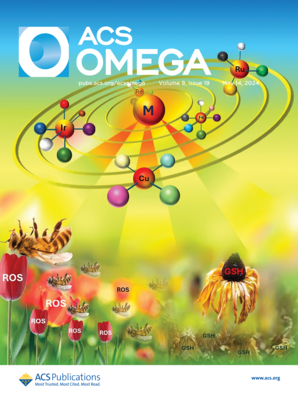制备掺锌二氧化钛纳米粒子以抑制大肠杆菌生长和肝癌细胞(HepG2)增殖
IF 4.3
3区 化学
Q2 CHEMISTRY, MULTIDISCIPLINARY
引用次数: 0
摘要
本研究采用共沉淀法合成了不同浓度(0、3 和 7 wt %)的掺锌 TiO2-NPs。在 TiO2-NPs 的不同衍射峰上出现了金红石型、锐钛型晶体结构,并通过 XRD 分析计算了晶体尺寸(12 至 24 nm)。通过扫描电镜分析观察到了球形、不规则、多孔的晶粒状表面形态,并通过傅立叶变换红外光谱分析确定了光谱表面附着的羟基、-C-O、-C-O-C 和 Ti-O-Ti 等不同官能团模式。然后,通过紫外-可见光分析,观察了 TiO2-NPs 中 Zn 浓度增加对吸光率的影响。然后,采用井扩散法测定抗菌活性,并使用 MTT 法研究对 HepG2 细胞株的抗癌活性。结果表明,随着掺锌 TiO2-NPs 浓度从 2 mm 增加到 32 mm,金黄色葡萄球菌和大肠杆菌的抑菌区也随之增加。7 wt % 的掺锌 TiO2-NPs 对肝癌细胞株具有显著的抗癌活性和抗菌活性。未来,掺杂 Zn 的 TiO2-NPs 可用于针对不同微生物和动物模型的体外分析,以治疗癌症。本文章由计算机程序翻译,如有差异,请以英文原文为准。

Fabrication of Zinc Doped Titanium Dioxide Nanoparticles to Inhibit Escherichia coli Growth and Proliferation of Liver Cancer Cells (HepG2)
The current research is related to the synthesis of different concentrations (0, 3, and 7 wt %) Zn doped TiO2-NPs by using the coprecipitation method. The rutile, anatase crystal structure appeared on different diffracted peaks in TiO2-NPs, and the crystallite size (12 to 24 nm) was calculated by using XRD analysis. The spherical, irregular, porous grain-like surface morphology was observed by SEM analysis, and the identification of different functional modes such as hydroxyl, −C–O, −C–O–C, and Ti–O–Ti attached on the surface of the spectrum was examined via FTIR analysis. After that, the increased absorbance of TiO2-NPs by increasing the Zn concentration in TiO2-NPs was observed by UV–visible analysis. After that, the well diffusion method was performed to measure antibacterial activity, and the MTT assay was used to investigate anticancer activity against the HepG2 cell line. It was observed that the inhibition zone of S. aureus and E. coli increased by increasing the concentration of Zn-doped TiO2-NPs from 2 to 32 mm. The 7 wt % Zn-doped TiO2-NPs provided significant anticancer activity against the liver cancer cell line and antibacterial activity. In the future, Zn doped TiO2-NPs can be used for in vitro analysis against different microbial and animal models for the treatment of cancer.
求助全文
通过发布文献求助,成功后即可免费获取论文全文。
去求助
来源期刊

ACS Omega
Chemical Engineering-General Chemical Engineering
CiteScore
6.60
自引率
4.90%
发文量
3945
审稿时长
2.4 months
期刊介绍:
ACS Omega is an open-access global publication for scientific articles that describe new findings in chemistry and interfacing areas of science, without any perceived evaluation of immediate impact.
 求助内容:
求助内容: 应助结果提醒方式:
应助结果提醒方式:


